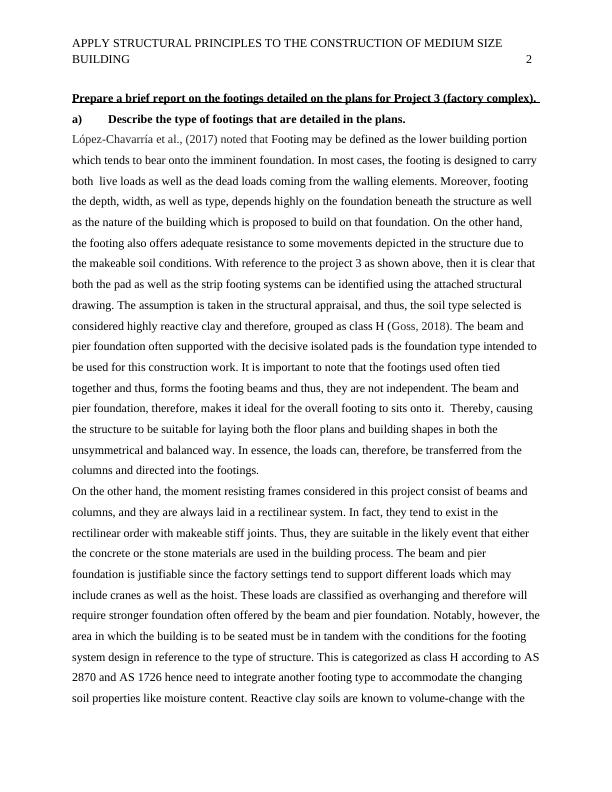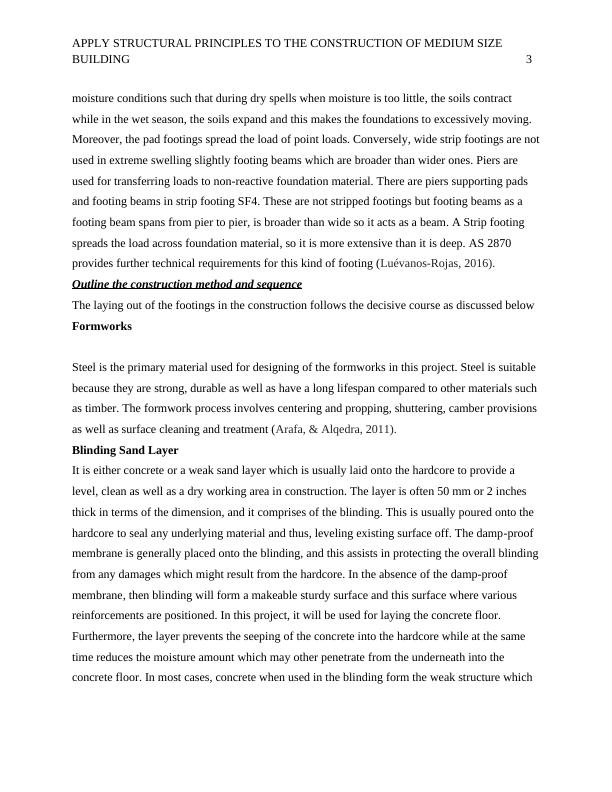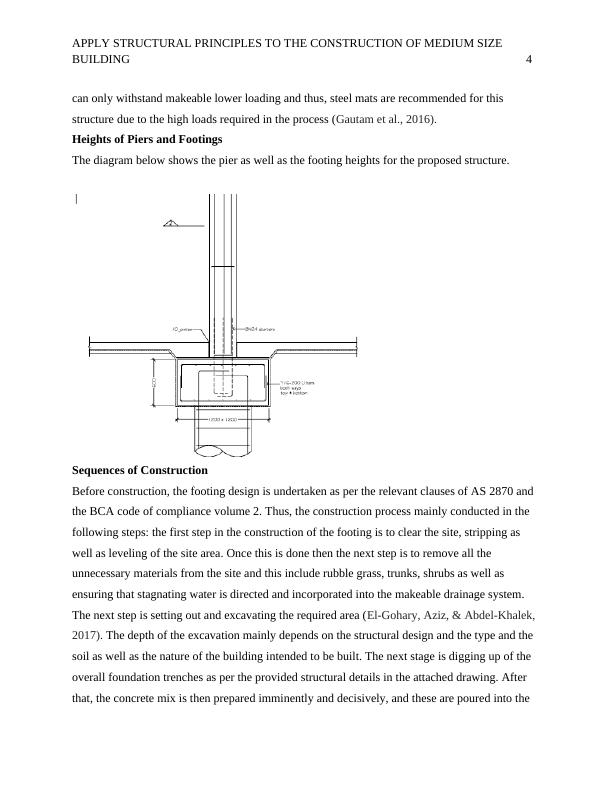Applying Structural Principles to Construct Medium Size Building
Added on 2023-06-10
13 Pages3394 Words243 Views
Running head: APPLY STRUCTURAL PRINCIPLES TO THE CONSTRUCTION OF
MEDIUM SIZE BUILDING 1
Apply Structural Principles to the Construction of Medium Size Building
Student Name
Institutional Affiliation
MEDIUM SIZE BUILDING 1
Apply Structural Principles to the Construction of Medium Size Building
Student Name
Institutional Affiliation

APPLY STRUCTURAL PRINCIPLES TO THE CONSTRUCTION OF MEDIUM SIZE
BUILDING 2
Prepare a brief report on the footings detailed on the plans for Project 3 (factory complex).
a) Describe the type of footings that are detailed in the plans.
López-Chavarría et al., (2017) noted that Footing may be defined as the lower building portion
which tends to bear onto the imminent foundation. In most cases, the footing is designed to carry
both live loads as well as the dead loads coming from the walling elements. Moreover, footing
the depth, width, as well as type, depends highly on the foundation beneath the structure as well
as the nature of the building which is proposed to build on that foundation. On the other hand,
the footing also offers adequate resistance to some movements depicted in the structure due to
the makeable soil conditions. With reference to the project 3 as shown above, then it is clear that
both the pad as well as the strip footing systems can be identified using the attached structural
drawing. The assumption is taken in the structural appraisal, and thus, the soil type selected is
considered highly reactive clay and therefore, grouped as class H (Goss, 2018). The beam and
pier foundation often supported with the decisive isolated pads is the foundation type intended to
be used for this construction work. It is important to note that the footings used often tied
together and thus, forms the footing beams and thus, they are not independent. The beam and
pier foundation, therefore, makes it ideal for the overall footing to sits onto it. Thereby, causing
the structure to be suitable for laying both the floor plans and building shapes in both the
unsymmetrical and balanced way. In essence, the loads can, therefore, be transferred from the
columns and directed into the footings.
On the other hand, the moment resisting frames considered in this project consist of beams and
columns, and they are always laid in a rectilinear system. In fact, they tend to exist in the
rectilinear order with makeable stiff joints. Thus, they are suitable in the likely event that either
the concrete or the stone materials are used in the building process. The beam and pier
foundation is justifiable since the factory settings tend to support different loads which may
include cranes as well as the hoist. These loads are classified as overhanging and therefore will
require stronger foundation often offered by the beam and pier foundation. Notably, however, the
area in which the building is to be seated must be in tandem with the conditions for the footing
system design in reference to the type of structure. This is categorized as class H according to AS
2870 and AS 1726 hence need to integrate another footing type to accommodate the changing
soil properties like moisture content. Reactive clay soils are known to volume-change with the
BUILDING 2
Prepare a brief report on the footings detailed on the plans for Project 3 (factory complex).
a) Describe the type of footings that are detailed in the plans.
López-Chavarría et al., (2017) noted that Footing may be defined as the lower building portion
which tends to bear onto the imminent foundation. In most cases, the footing is designed to carry
both live loads as well as the dead loads coming from the walling elements. Moreover, footing
the depth, width, as well as type, depends highly on the foundation beneath the structure as well
as the nature of the building which is proposed to build on that foundation. On the other hand,
the footing also offers adequate resistance to some movements depicted in the structure due to
the makeable soil conditions. With reference to the project 3 as shown above, then it is clear that
both the pad as well as the strip footing systems can be identified using the attached structural
drawing. The assumption is taken in the structural appraisal, and thus, the soil type selected is
considered highly reactive clay and therefore, grouped as class H (Goss, 2018). The beam and
pier foundation often supported with the decisive isolated pads is the foundation type intended to
be used for this construction work. It is important to note that the footings used often tied
together and thus, forms the footing beams and thus, they are not independent. The beam and
pier foundation, therefore, makes it ideal for the overall footing to sits onto it. Thereby, causing
the structure to be suitable for laying both the floor plans and building shapes in both the
unsymmetrical and balanced way. In essence, the loads can, therefore, be transferred from the
columns and directed into the footings.
On the other hand, the moment resisting frames considered in this project consist of beams and
columns, and they are always laid in a rectilinear system. In fact, they tend to exist in the
rectilinear order with makeable stiff joints. Thus, they are suitable in the likely event that either
the concrete or the stone materials are used in the building process. The beam and pier
foundation is justifiable since the factory settings tend to support different loads which may
include cranes as well as the hoist. These loads are classified as overhanging and therefore will
require stronger foundation often offered by the beam and pier foundation. Notably, however, the
area in which the building is to be seated must be in tandem with the conditions for the footing
system design in reference to the type of structure. This is categorized as class H according to AS
2870 and AS 1726 hence need to integrate another footing type to accommodate the changing
soil properties like moisture content. Reactive clay soils are known to volume-change with the

APPLY STRUCTURAL PRINCIPLES TO THE CONSTRUCTION OF MEDIUM SIZE
BUILDING 3
moisture conditions such that during dry spells when moisture is too little, the soils contract
while in the wet season, the soils expand and this makes the foundations to excessively moving.
Moreover, the pad footings spread the load of point loads. Conversely, wide strip footings are not
used in extreme swelling slightly footing beams which are broader than wider ones. Piers are
used for transferring loads to non-reactive foundation material. There are piers supporting pads
and footing beams in strip footing SF4. These are not stripped footings but footing beams as a
footing beam spans from pier to pier, is broader than wide so it acts as a beam. A Strip footing
spreads the load across foundation material, so it is more extensive than it is deep. AS 2870
provides further technical requirements for this kind of footing (Luévanos-Rojas, 2016).
Outline the construction method and sequence
The laying out of the footings in the construction follows the decisive course as discussed below
Formworks
Steel is the primary material used for designing of the formworks in this project. Steel is suitable
because they are strong, durable as well as have a long lifespan compared to other materials such
as timber. The formwork process involves centering and propping, shuttering, camber provisions
as well as surface cleaning and treatment (Arafa, & Alqedra, 2011).
Blinding Sand Layer
It is either concrete or a weak sand layer which is usually laid onto the hardcore to provide a
level, clean as well as a dry working area in construction. The layer is often 50 mm or 2 inches
thick in terms of the dimension, and it comprises of the blinding. This is usually poured onto the
hardcore to seal any underlying material and thus, leveling existing surface off. The damp-proof
membrane is generally placed onto the blinding, and this assists in protecting the overall blinding
from any damages which might result from the hardcore. In the absence of the damp-proof
membrane, then blinding will form a makeable sturdy surface and this surface where various
reinforcements are positioned. In this project, it will be used for laying the concrete floor.
Furthermore, the layer prevents the seeping of the concrete into the hardcore while at the same
time reduces the moisture amount which may other penetrate from the underneath into the
concrete floor. In most cases, concrete when used in the blinding form the weak structure which
BUILDING 3
moisture conditions such that during dry spells when moisture is too little, the soils contract
while in the wet season, the soils expand and this makes the foundations to excessively moving.
Moreover, the pad footings spread the load of point loads. Conversely, wide strip footings are not
used in extreme swelling slightly footing beams which are broader than wider ones. Piers are
used for transferring loads to non-reactive foundation material. There are piers supporting pads
and footing beams in strip footing SF4. These are not stripped footings but footing beams as a
footing beam spans from pier to pier, is broader than wide so it acts as a beam. A Strip footing
spreads the load across foundation material, so it is more extensive than it is deep. AS 2870
provides further technical requirements for this kind of footing (Luévanos-Rojas, 2016).
Outline the construction method and sequence
The laying out of the footings in the construction follows the decisive course as discussed below
Formworks
Steel is the primary material used for designing of the formworks in this project. Steel is suitable
because they are strong, durable as well as have a long lifespan compared to other materials such
as timber. The formwork process involves centering and propping, shuttering, camber provisions
as well as surface cleaning and treatment (Arafa, & Alqedra, 2011).
Blinding Sand Layer
It is either concrete or a weak sand layer which is usually laid onto the hardcore to provide a
level, clean as well as a dry working area in construction. The layer is often 50 mm or 2 inches
thick in terms of the dimension, and it comprises of the blinding. This is usually poured onto the
hardcore to seal any underlying material and thus, leveling existing surface off. The damp-proof
membrane is generally placed onto the blinding, and this assists in protecting the overall blinding
from any damages which might result from the hardcore. In the absence of the damp-proof
membrane, then blinding will form a makeable sturdy surface and this surface where various
reinforcements are positioned. In this project, it will be used for laying the concrete floor.
Furthermore, the layer prevents the seeping of the concrete into the hardcore while at the same
time reduces the moisture amount which may other penetrate from the underneath into the
concrete floor. In most cases, concrete when used in the blinding form the weak structure which

APPLY STRUCTURAL PRINCIPLES TO THE CONSTRUCTION OF MEDIUM SIZE
BUILDING 4
can only withstand makeable lower loading and thus, steel mats are recommended for this
structure due to the high loads required in the process (Gautam et al., 2016).
Heights of Piers and Footings
The diagram below shows the pier as well as the footing heights for the proposed structure.
Sequences of Construction
Before construction, the footing design is undertaken as per the relevant clauses of AS 2870 and
the BCA code of compliance volume 2. Thus, the construction process mainly conducted in the
following steps: the first step in the construction of the footing is to clear the site, stripping as
well as leveling of the site area. Once this is done then the next step is to remove all the
unnecessary materials from the site and this include rubble grass, trunks, shrubs as well as
ensuring that stagnating water is directed and incorporated into the makeable drainage system.
The next step is setting out and excavating the required area (El-Gohary, Aziz, & Abdel-Khalek,
2017). The depth of the excavation mainly depends on the structural design and the type and the
soil as well as the nature of the building intended to be built. The next stage is digging up of the
overall foundation trenches as per the provided structural details in the attached drawing. After
that, the concrete mix is then prepared imminently and decisively, and these are poured into the
BUILDING 4
can only withstand makeable lower loading and thus, steel mats are recommended for this
structure due to the high loads required in the process (Gautam et al., 2016).
Heights of Piers and Footings
The diagram below shows the pier as well as the footing heights for the proposed structure.
Sequences of Construction
Before construction, the footing design is undertaken as per the relevant clauses of AS 2870 and
the BCA code of compliance volume 2. Thus, the construction process mainly conducted in the
following steps: the first step in the construction of the footing is to clear the site, stripping as
well as leveling of the site area. Once this is done then the next step is to remove all the
unnecessary materials from the site and this include rubble grass, trunks, shrubs as well as
ensuring that stagnating water is directed and incorporated into the makeable drainage system.
The next step is setting out and excavating the required area (El-Gohary, Aziz, & Abdel-Khalek,
2017). The depth of the excavation mainly depends on the structural design and the type and the
soil as well as the nature of the building intended to be built. The next stage is digging up of the
overall foundation trenches as per the provided structural details in the attached drawing. After
that, the concrete mix is then prepared imminently and decisively, and these are poured into the

End of preview
Want to access all the pages? Upload your documents or become a member.
Related Documents
Institutional Affiliation Assessment 2022lg...
|15
|3066
|14
Sittingbourne Footing System Assignmentlg...
|27
|1880
|48
Construction Managementlg...
|11
|1575
|71
Building and Construction Assignment: Footings, Construction Methods, Equipment, Wall Panel Support, and Termite Protectionlg...
|11
|2259
|328
Footing Systems and Structural Design of a Low Rise Concrete Frame Buildinglg...
|23
|3427
|404
CPCCBC4010B Apply Structural Principles to Residential Lowlg...
|3
|653
|145